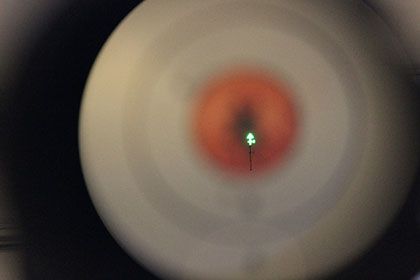The following is paid content sponsored by Trijicon
By Sean Curtis for Police1 BrandFocus
How do you take an optical legend and make it better? The simple answer is adding more capability. When the ability comes from battlefield feedback, it carries the weight of real-world application. Trijicon did just that, with their 3.5x35 LED ACOG.
History
The ACOG has served for years in military and civilian applications in a number of different models. The original 4x32, an icon, has sold nearly a million units. What separates the ACOG from its competitors is how it blends many different optic needs, such as the desire for up close and personal with some ability to reach out and touch, seamlessly. Only the uninitiated need be informed of the absolute durability of the ACOG, which has been used in several theaters of war serving multiple branches of the armed forces in numbers ranging in the hundreds of thousands. In addition, the field of the view is so voluminous, the ACOG was associated with an aiming technique of keeping both eyes open to allow the user to cover the target with the reticle while viewing the entire field of view.
Evolution
I spoke with Ryan Wood, ACOG Product Manager at Trijicon, about what makes the newest version of the ACOG better than previous iterations. Wood said the company maintained the same rugged durability that earned the ACOG its reputation while adding additional features that would increase its value. Namely, the TA110 has now dropped the fiber optic and tritium in exchange for a LED-illuminated reticle system. Users of previous versions will accordingly note the new battery tube on the right side of the unit as well as a numbered dial on the left.
Wood said the they went with a AA battery to power the unit (recommend a lithium style battery). The main idea for this power source is availability, adding to overall value. Further, he said the unit will last 12,000 hours on a setting of 4—a medium brightness—on that battery. The light adjusting dial has a total of six settings with the first being compatible with night vision. The highest setting is good for bright light environments.
Design details like a solid tactile feel on the adjustment knob allow users to grip and manipulate the optic with or without gloves. Trijicon has no illusions about how and where their optics are being utilized. Wood insisted they were able to implement this critical feature, allowing operators to contend with transitional lighting, without sacrificing durability.
Slick Mounting System
I mounted the TA110 to the rail of my AR15 and found the process easy thanks to the TA51 mount. Unlike other rail applications where bolts or nuts can back all the way off, this system allowed me to unscrew the nuts, mount the unit, and tighten without anything coming apart or being dropped. This adds utility because I can safely remove or mount the unit in the field without fear of losing any critical hardware. Securely mounted, I inspected the reticle.
 |
| The ACOG features an LED-illuminated reticle system. (Photo/Sean Curtis) |
The 3.5x35 unit I tested came equipped with a reticle featuring an up pointing chevron and five holdover hash marks running down a vertical line below the chevron. No windage was represented. The 3.5 power magnification is evident, though not obnoxious at close range. However, it comes in handy when the eye begins to reach out to targets not in an immediate vicinity.
An illuminating new design
The dial on the left provides perhaps the greatest enhancement to a battle-proven optic, user-controlled illumination. The unit lit the chevron and first crosshair as green at the first position. This dim setting was certainly a low-light or no light setting though, capable of syncing with night vision. Moving up through the settings I found Trijicon had considered the positional settings of their various reticle lightings by adding an off detent between each setting. This means, by practical application, that users can select a lighting setting for their reticle (4 perhaps) and leave it there. When transitioning to the dark, they can activate it with a single click. When moving to the light, operators can do the opposite without losing situational awareness to scroll through a litany of reticle brightness options.
I tested the LED ACOG in multiple lighting settings and found this utility to be critical. I imagined the need to transition from bright daylight to a dim setting in an unlit house once I had breached a door. With the control knob mounted on the left side of the optic I could engage it left-handed without sacrificing my trigger finger and sight picture. One deft click of the knob illuminated the crosshair and chevron giving me absolute confidence in otherwise ambiguous target scenarios. The knob is also sturdy and will not simply roll through the setting with incidental contact.
Final thoughts
The TA110 LED ACOG by Trijicon adds to the legacy of a battle worn hero. Building upon the already legendary durability, the LED version adds the incredible capability of an illuminated reticle combined with a full field of view. This capability is powered by a single, widely available, AA battery, and runs the unit for an impressive amount of continual use time. Designers implemented an off detent between each brightness setting so a valuable real-world transition between light settings is achievable for shooters needing to adjust to various scenarios. The LED ACOG is an evolution, bringing added value to a hallmark optic.
For more information about the ACOG, visit Trijicon.
About the author
Sean Curtis is a law enforcement professional with 15 years of experience, serving with SWAT, diving, and swift water rescue teams in Colorado. He has also served in wildland fire, search and rescue, EMS, and emergency management.



